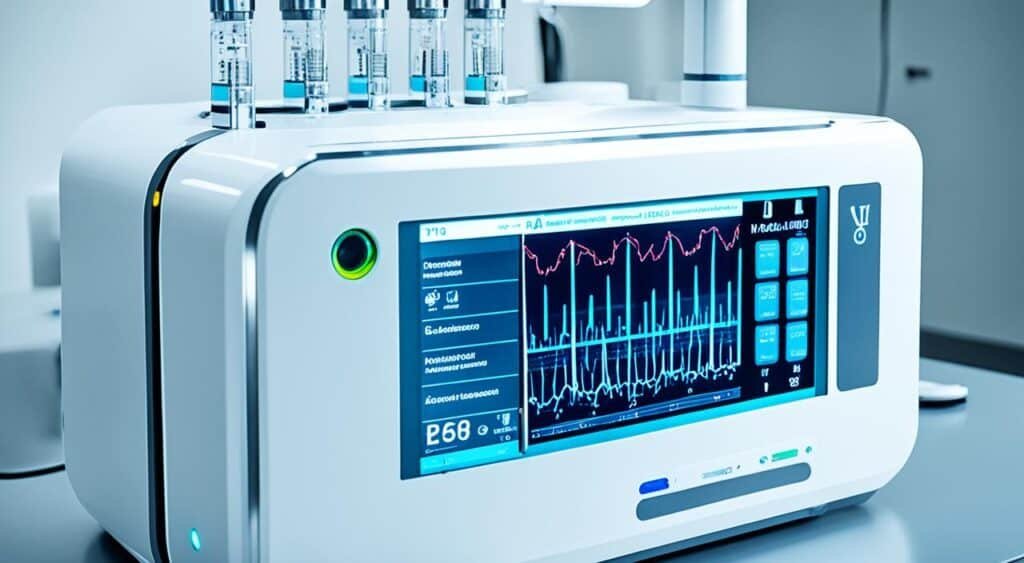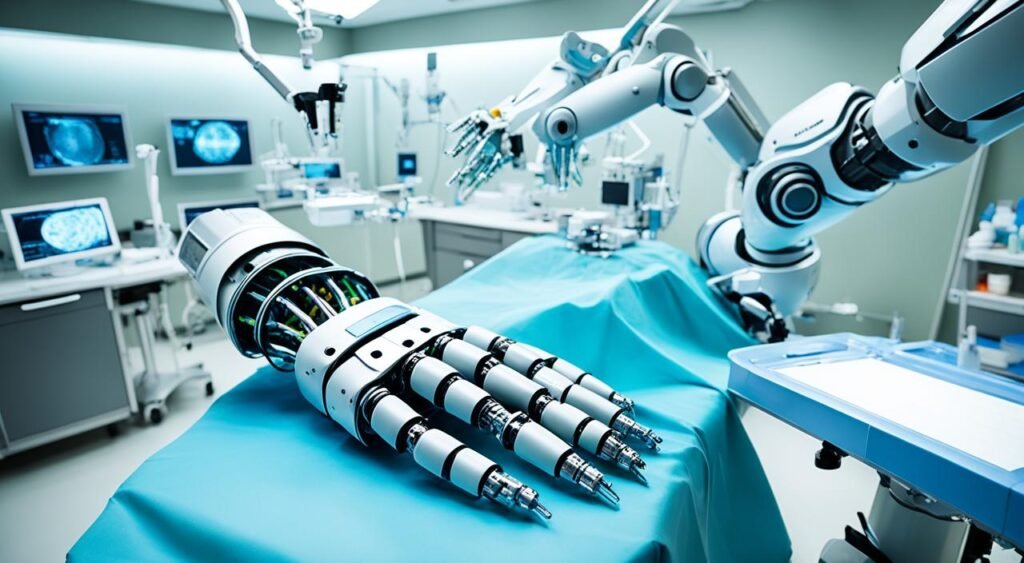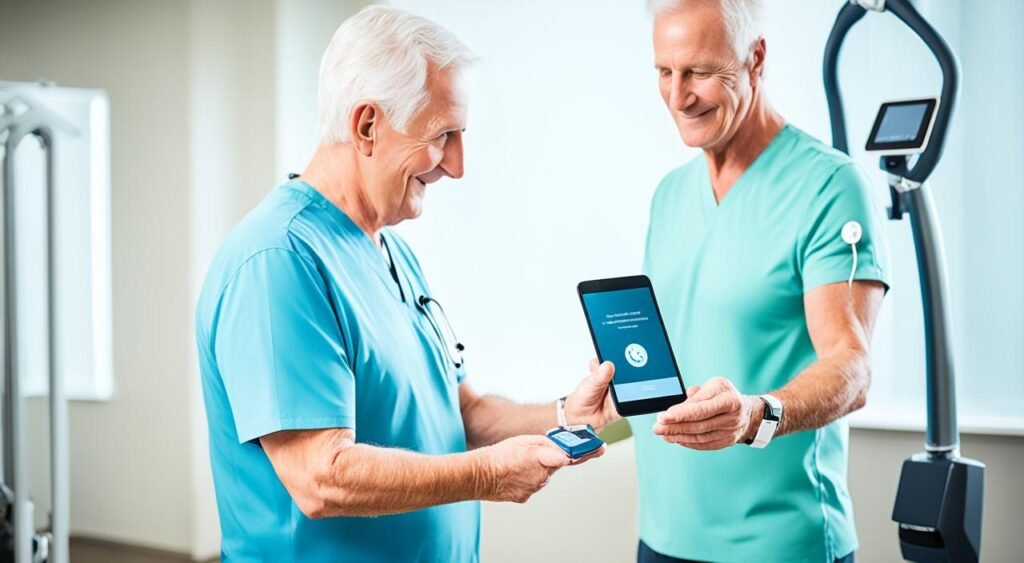Health technology includes a wide range of digital innovations and tools. They are made to improve how healthcare is given, help patients do better, and make healthcare services run smoother. This area covers things like medical devices, tools for diagnosis, technologies for therapy, platforms for digital healthcare, AI, telemedicine, 3D printing, and surgical robots. All these technologies help healthcare be more efficient, accurate, and available. They also encourage patients to be more in control of their health.
Key Takeaways
- Health technology encompasses a wide range of digital tools and innovations used in healthcare
- These technologies aim to enhance patient care, improve outcomes, and streamline healthcare operations
- Health technologies include medical devices, diagnostic tools, digital platforms, AI, telemedicine, 3D printing, and robotic systems
- These innovations are revolutionizing the healthcare industry by increasing efficiency, accuracy, and accessibility of care
- Health technologies empower patients to take a more active role in managing their own health
Introduction to Health Technology
Health technology covers a wide range of innovations that aim to improve healthcare. It includes medical devices, software, and digital platforms. These tools are changing the way we provide and receive healthcare.
Definition and Overview
At its core, health technology is any tech that helps healthcare. This can be physical devices, software, or online portals. Everything from fitness trackers to AI disease tools fall under this term.
The world of health technology is always changing. Trends like digital transformation and using tech to make healthcare better are on the rise. These changes are making healthcare more accessible and efficient for everyone involved.
| Health Technology Category | Examples |
|---|---|
| Medical Devices | Wearable fitness trackers, implantable pacemakers, robotic surgical systems |
| Healthcare Software | Electronic health records (EHRs), telehealth platforms, AI-powered diagnostic tools |
| Digital Health Platforms | Mobile health apps, patient engagement portals, remote patient monitoring systems |
Knowing the definition and overview of health technology helps us see its importance. These innovations are at the forefront of changing how we do healthcare.
Medical Devices and Technologies

Medical devices are key in today’s healthcare. They let doctors diagnose, treat, and keep track of medical issues. Innovations like MRI machines and pacemakers improve patient care a lot.
Diagnostic Tools and Therapeutic Devices
Diagnosis tools help find out what’s wrong with a person’s health. This can be through imaging devices or genetic tests. Therapeutic devices are used to treat health problems. They can be tools for surgery, drug delivery, or even helping someone walk again.
Modern healthcare tools are becoming more digital and connected. Digital health devices and connected health devices help patients get more involved in their care. This includes being able to check on health remotely and talk to doctors online.
| Diagnostic Tools | Therapeutic Devices |
|---|---|
|
|
When medical devices, healthcare technology, diagnostic tools, and therapeutic devices work together, doctors can offer better care. This makes treatment more personal, effective, and efficient. It helps patients get better and take charge of their health.
“Medical devices and technologies are the driving force behind many of the advancements we see in modern healthcare.”
Digital Healthcare and Health Informatics
In today’s world, health technology is moving forward fast. Digital healthcare and health informatics are key areas of this growth. They use new technology, data analytics, and digital tools to change how we deal with healthcare.
The cornerstone of digital healthcare is the electronic health record (EHR) system. This system makes it easy to collect, store, and look after patient data. It helps healthcare workers do their job better by allowing them to access data fast and make better decisions. Also, by analyzing this data, insights are found that can improve care, how we use resources, and help patients more.
Telehealth is also becoming more important in the digital health world. It allows people to see their healthcare providers without being face-to-face. This includes remote consultations and keeping an eye on how patients are doing. It makes getting healthcare easier and less costly. Plus, it’s good for preventing illnesses.
Health informatics mixes information technology, data handling, and healthcare know-how. It aims to make healthcare IT systems better. This includes tools like electronic medical records (EMRs), clinical decision support tools, and ways to manage public health. People in health informatics make sure healthcare information is safe and helps make healthcare decisions better for patients.
The changes digital healthcare and health informatics can bring are big. Using new technology can make healthcare work better, personalize care, and improve patients’ lives. The future of healthcare is tied to digital stuff, and those who welcome these changes will help make healthcare more effective, efficient, and focused on patients.
“The future of healthcare is digital, and those who embrace these advancements will be poised to lead the charge towards a more efficient, effective, and patient-centric healthcare system.”
Health Technology

Healthcare technology is changing quickly, making medical care better for patients. Today, we have new tools and devices that help doctors to be more accurate and quicker in their work. This digital revolution is not only making healthcare better but also more accessible.
Wearable fitness trackers help people keep track of their health. They encourage everyone to be involved in staying healthy. Telemedicine makes it possible for patients to see a doctor without going to the hospital. It makes getting healthcare easier and reduces the need for crowded waiting rooms.
Artificial intelligence, or AI, is also changing healthcare. AI can now help diagnose diseases better and faster than ever before. 3D printing is offering new possibilities in creating prosthetics, making custom prosthetics more affordable and enhancing the lives of those with mobility issues.
As healthcare advances, it’s key to bring in new healthcare technologies and medical technologies. Doing this will make healthcare better, cheaper, and more digital. By adopting these innovative healthcare solutions, doctors and policymakers can improve the care they provide to their patients.
“The future of healthcare is digital, and the widespread adoption of emerging health technologies will be key to driving better patient outcomes and transforming the industry as a whole.”
From wearables to advanced AI diagnostics, health technology is growing fast. It’s giving us chances to make healthcare better, more available, and affordable. For healthcare workers and policymakers, including these emerging health technologies is important to provide the best care to patients.
Artificial Intelligence in Healthcare
Artificial intelligence is transforming healthcare by providing new ways to face medical challenges. These modern tools help doctors by analyzing massive amounts of data. They look at medical images and patient records to help with diagnosing illnesses, finding new drugs, and planning personalized treatments.
AI-powered diagnostics is a leading field thanks to AI. With this, AI algorithms quickly check medical scans for any signs of disease. They often do this better than human radiologists. This advancement is changing how we find health problems early, which is good news for patient recovery.
Another key area in healthcare is predictive analytics powered by AI. AI tools can predict who is at risk of getting sick. They look at patients’ past health and current data. This helps in planning for future health needs and making care more personalized.
As machine learning in healthcare advances, we see AI’s potential more clearly. These tools do many things, from finding new medicines to making office work smoother. They promise to make healthcare more efficient, accurate, and personal. This would mean better health outcomes for everyone and a healthcare system that’s more reliable.
“AI is not about replacing doctors, it’s about empowering them to provide better care.”
Telemedicine and Remote Healthcare
Telemedicine and remote healthcare are becoming more important in our world. They change how people get medical help. These new ways make it easier and better to visit the doctor. They help whether you’re not close to a clinic or can’t move very well.
Virtual Consultations and Remote Monitoring
With telemedicine, you can see your doctor without going to the office. You use video calls or messages to talk to them. This is great for anyone who can’t travel easily or needs to see a specialist far away.
Doctors can also keep an eye on your health from afar. They use devices that you wear or have at home. These devices send important health information to your doctor. This helps them spot any issues quickly or adjust your care as needed.
Telemedicine and remote monitoring work together to make healthcare better. These allow people to be more involved in their health. By doing this, healthcare becomes more focused on the person and works better for everyone.
“Telemedicine and remote healthcare technologies are revolutionizing the way we think about and deliver medical care. They are not just improving access and convenience, but also enabling more proactive and personalized healthcare solutions.”
| Benefits of Telemedicine and Remote Healthcare | Challenges and Limitations |
|---|---|
|
|
As medicine changes, telemedicine will become even more important. It will make medical help better and easier to reach. Doctors can use new tools to help you stay healthy. And you can also learn more about how to keep well. This new healthcare system is good for everyone.
3D Printing in Healthcare
3D printing is changing the way healthcare works. It allows for custom-made medical tools, like devices, prosthetics, and implants. These items are made to fit a person’s unique needs. This not only makes medical tools work better but it also cuts down costs and waste.
Custom-made prosthetics are a key use of 3D printing. Regular prosthetic limbs might not fit perfectly. They can cause pain and limit what someone can do. 3D printing solves this problem. It lets doctors and makers create prosthetics that perfectly fit. This makes life easier for the person wearing them.
3D printed implants are also making surgeries better. Doctors can craft implants for bones, teeth, and faces that match perfectly. This lowers the chance of issues and makes treatments more effective.
3D printing isn’t just for making medical tools. It’s also helping plan surgeries better. By making models of a patient’s body, doctors can practice tough surgeries. This makes operations safer and more exact.
| Application | Benefits |
|---|---|
| Personalized Prosthetics | Improved fit, function, and comfort for patients |
| Custom Implants | Seamless integration with patient’s anatomy, reduced complications |
| 3D-Printed Anatomical Models | Enhanced surgical planning, improved patient safety and outcomes |
As the healthcare world uses 3D printing more, we’ll see new and creative ways to help patients. This will lower costs and push medical technology forward.
“3D printing is revolutionizing the way we approach healthcare, enabling us to provide personalized, on-demand solutions that truly meet the unique needs of each patient.”
Robotics and Surgical Technologies

In healthcare, robotics and advanced surgical technologies are changing medical procedures. Robotic surgery uses the da Vinci Surgical System. It lets surgeons do complex procedures with precise control and dexterity.
Surgical robotics help in making smaller cuts, less blood loss, and quick recoveries. These techs improve how patients are taken care of. Also, tools like computer guides in surgery and systems using augmented reality make operations more accurate. They help in better patient outcomes and lower the chance of problems.
Minimally Invasive Procedures and Robotic Assistance
Robotic-assisted surgery is great at doing minimally invasive procedures. Surgeons use small, high-tech tools to work on the body through tiny cuts. This causes less harm and helps patients heal faster.
- Improved dexterity and maneuverability: Robotic systems offer surgeons enhanced range of motion and flexibility, allowing for more precise and controlled movements during complex procedures.
- Enhanced visualization: High-definition 3D cameras provide surgeons with a magnified, detailed view of the surgical site, enhancing their ability to navigate and operate with exceptional precision.
- Reduced surgical errors: The steady, tremor-free movements of robotic arms and instruments help to minimize the risk of human error, leading to safer and more reliable surgical outcomes.
Computer-assisted surgery and augmented reality make robotic systems even better. They help doctors plan, simulate, and do surgeries with perfect accuracy and speed.
“Robotic-assisted surgery has opened up new possibilities in minimally invasive procedures, allowing us to tackle complex cases with greater precision and control than ever before.” – Dr. Emma Watkins, Chief of Surgery
Also Read : What’s The Cloud And How Does It Store Data?
Health Technology and Patient Empowerment

Health technology changes how we receive care and helps people take charge of their health. Devices we can wear, mobile apps for health, and online health records let us check important health information anytime. This helps us look after our health conditions, see how we’re doing, and talk better with our doctors.
These digital health tools make care more about the patient. They let patients and doctors decide on care together and be more responsible for managing long-term health issues. This often leads to better health results and makes patients more involved in their own care.
Wearable tech includes devices like fitness trackers and watches. They help keep an eye on our health signs, activity levels, and sleep. This info can easily go to our doctors, so they can offer care that’s just for us. Mobile apps are also useful. They let patients follow their symptoms, take their medicines right, and care for other health areas, promoting patient responsibility and well-being.
Then, there are patient portals. They give us a safe way to see our health records, test results, and when we have appointments. This openness helps us work closely with our health team. It makes deciding on our care easier and makes sure we stick to the treatment plans better.
Health technology lets patients be in the driver’s seat of their health journey. It helps us do better in our health goals and makes us happier with our care.
“Health technology has the potential to transform the patient-provider relationship, empowering individuals to become active participants in their care.”
Conclusion
The healthcare industry has changed a lot because of new health tech. This includes state-of-the-art medical devices, digital health tools, and AI. These things are changing how we do healthcare.
New tech like telemedicine, 3D printing for medical needs, and AI in health are becoming more popular. They make healthcare more efficient and accurate. They also help people play a bigger part in their health.
Health technology is not just for doctors. It helps everyone get better healthcare and moves the whole sector forward. We are entering a time where high-tech and personal care will merge. We will see better health results for everyone.
FAQs
What is health technology?
Health technology is a wide array of tools that make healthcare better. It includes things like medical devices, diagnostic tools, and digital healthcare platforms. Also, artificial intelligence, telemedicine, 3D printing, and robotic surgeries are part of it. These things help improve how healthcare is given, making it easier for the doctors and helping patients get better results.
What are the key components of health technology?
Medical tools and devices are very important in health technology. Then, there’s digital health and health informatics, which keep track of health information. Other key parts are artificial intelligence, telemedicine, 3D printing, and robot surgeries. All these parts work together to make healthcare more effective and accessible.
How is artificial intelligence transforming healthcare?
Artificial intelligence (AI) is changing the way we do healthcare. It helps by looking at a lot of data, like medical images and patient records. With this help, doctors can better diagnose diseases, find new drugs, and plan treatments. AI also makes it easier for hospitals to predict needs and give better care, helping patients more.
What is the role of telemedicine and remote healthcare technologies?
Remote healthcare and telemedicine are more important now than ever. They let patients and doctors talk without meeting in person. This is very useful for diagnosis, follow-up care, and treatments. Devices that monitor the patient’s health at home are also used. It’s a part of healthcare that can happen without actually going to the hospital.
How is 3D printing transforming healthcare?
3D printing is making big changes in healthcare. It allows the creation of medical devices, prosthetics, and implants that fit perfectly. Surgeons also use 3D-printed models to plan surgeries and help patients understand. This way, treatments are more personalized and effective.
What is the impact of robotics and advanced surgical technologies in healthcare?
Robots and advanced surgeries are changing how operations are done. Technologies like the da Vinci Surgical System make surgeries better. They help by making smaller cuts, which means less blood loss and quicker recoveries for patients. These advances are making surgeries easier and safer for everyone.
How is health technology empowering patients?
Health tech is not just for doctors, it also helps patients take control of their health. Wearable devices, health apps, and patient portals give people direct access to their health information. This lets patients watch their health, progress, and talk easily with doctors. It’s a big step in making healthcare personalized and focused on the patient.
